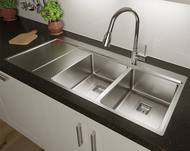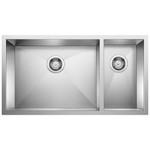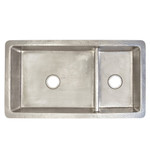Today’s kitchen sink has become a multitasking center. Homeowners are using their kitchen to wash and rinse dishes, clean vegetables, soak pots and pans, get hot water from the instant hot and even bathe children. The list goes on and on. It should come as no surprise that studies indicate that homeowners spend up to 50% of their time in the kitchen in front of the sink.
Until recently, the most common types of sinks have been cast iron and stainless steel. However, as the size and importance of the kitchen has grown, sink options have expanded to enable homeowners to customize their kitchens. Today, the kitchen sink can be a statement piece because they now come in a wide variety of shapes, sizes, colors, materials and mounting options.
As kitchens continue to grow in size, efficiency is more difficult to obtain. Yes, there’s more room, but the space needs to be organized and workable. That’s why in larger kitchens we often recommend installing two sinks: a prep sink, generally facing a social area so you can face your guests and family members during meal preparation, and a main sink used mostly for cleanup.
Today’s Kitchen Sink Trends
A number of our customers are attracted to farmhouse or apron front sinks. Farmhouse sinks are typically deeper than stainless steel undermount or top-mounted sinks, and they are generally easier to clean. This is because farmhouse sinks are installed under the countertop, making it easier to wipe excess water or food scraps into the sink. Farmhouse sinks also are easier on the back because they bring the sink closer to the user.
Fireclay is the most common material used to make farmhouse sinks. Fireclay sinks are capable of withstanding extremely high temperatures while maintaining their original shape and size. This high firing temperature fuses the clay base with glazes to provide an extremely strong finish that is scratch, chip and stain-resistant. Other popular materials used to make farmhouse sinks are stainless steel, natural stone, copper, cast iron, concrete, and composite materials.
Many homeowners who do not choose a farmhouse sink opt for an undermount sink instead. Undermount sinks are fastened to the underside of a solid surface countertop such as granite, quartz and engineered stone. The lip where the sink meets counter features a finished edge, and the faucet in this application is typically mounted to the countertop. We advise homeowners to decide if the countertop should hang over the sink, if it should be set back from the lip letting the sink show, or if the countertop should be flush with the side of the sink. Based on the customer’s preference, we can provide direction to the contractor or countertop fabricator.
Other mounting options are drop-in, flush mount or surface mounted. The choice of countertop material affects the mounting system used. Drop-in sinks have a lip that rests on the countertop surface with an integral rim. In the past, this was the traditional method of mounting sinks, especially on tile. This sink is literally dropped into a cutout in the countertop. Drop-in sinks are often cast iron or stainless steel and ringed by a large, raised lip that rests on the countertop surface. Stainless steel drop-in sinks have much flatter lips. Typically, the faucet is mounted to the sink.
Flush mounted sinks are set into the counter and align evenly with the countertop material (generally tile). These are referred to as a tile-in-flange. This is rarely found in today’s kitchens.
The biggest trend we are seeing in today’s kitchen sinks are accessories. Many sinks are offering cutting boards, colanders and other accessories to make prepping easier.




